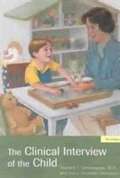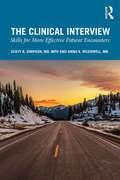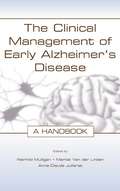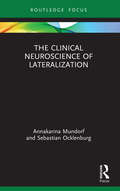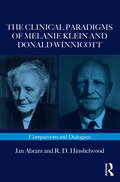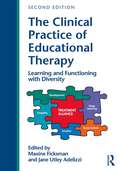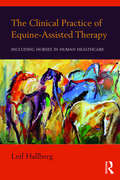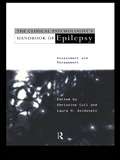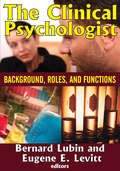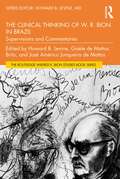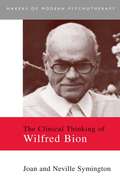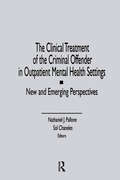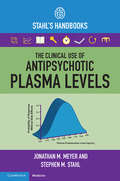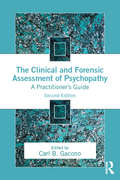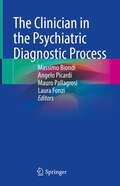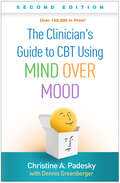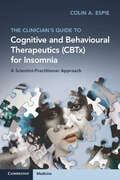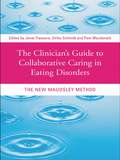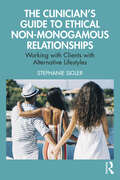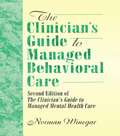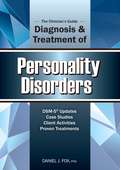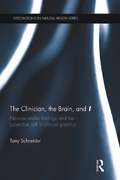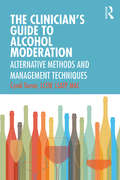- Table View
- List View
The Clinical Interview of the Child
by Stanley I. Greenspan Nancy Thorndike GreenspanIdeal for both novices and advanced practitioners, the new edition of Stanley Greenspan's classic guide outlines a practical process for observing and interviewing children -- and organizing and interpreting their unfolding communications. The third edition has been expanded and revised extensively, with updated theoretical and conceptual foundations; information on higher levels of ego development and reflective and thinking capacities of older children; and a new section on a developmental biopsychosocial model -- the developmental, individual-difference, relationship-based (DIR) approach. An invaluable educational and practical resource, The Clinical Interview of the Child, Third Edition, is an ideal tool for psychiatrists and psychologists, pediatricians, educators, social workers, speech pathologists, occupational therapists, and judges and attorneys dealing with children and families.
The Clinical Interview: Skills for More Effective Patient Encounters
by Scott A. Simpson Anna Kari McDowellThe Clinical Interview offers a new perspective on the patient encounter. Interpreting decades of evidence-based psychotherapy and neuroscience, it provides 60 succinct techniques to help clinicians develop rapport, solicit better histories, and plan treatment with even the most challenging patients. This book describes brief skills and techniques for clinical providers to improve their patient interactions. Although evidence-based psychotherapies are typically designed for longer specialized treatments, elements of these psychotherapies can help clinicians obtain better patient histories, develop more effective treatment plans, and more capably handle anxiety-provoking interactions. Each chapter is brief and easily digestible, contains sample clinical dialogue, and provides references for further reading. These skills help clinicians practice more effectively, more efficiently, and with greater resilience. Whatever your clinical specialty or role, whether you are a trainee or an experienced clinician, The Clinical Interview offers practical wisdom and an entirely new way to think about the clinical encounter. The Clinical Interview will be of great use to any student in a health-related field of study or a healthcare professional interested in refining their interviewing skills. It will help anyone from emergency medical technicians, nurses, and physician assistants, to nurse practitioners and physicians to build more meaningful patient relationships.
The Clinical Management of Early Alzheimer's Disease: A Handbook
by Reinhild Mulligan Martial Van der Linden Anne-Claude JuilleratThe enormous human and economic toll of Alzheimer's Disease in societies in which more and more people are living into old age is well-recognized. Scientists and practitioners alike have been working to limit it. Their major focus has been patients in the later stages of the disease, when dementia is fully established. Yet patients in the early stages of cognitive decline, far more numerous, often still living independently with family members, present a bewildering variety of challenges. Bringing together leading authors with diverse expertise, this Handbook offers the first comprehensive overview of approaches to the management of early-stage issues. The authors summarize the important implications of the latest research in their own fields for: * the recognition and formal diagnosis of cognitive problems; * the assessment of specific difficulties in daily functioning; * the formulation of a management plan integrating pharmacological, neuropsychological, behavioral, and cognitive strategies; and * the facilitation and support of caregivers' efforts. All professionals involved in any way with the care of early Alzheimer's patients and their families will find this book an indispensable reference.
The Clinical Neuroscience of Lateralization
by Annakarina Mundorf Sebastian OcklenburgThe Clinical Neuroscience of Lateralization gives the first comprehensive transdiagnostic overview of the evidence for changes in hemispheric asymmetries in different psychiatric and neurodevelopmental disorders. Taking a multidisciplinary perspective informed by both basic science and clinical studies, the authors integrate recent breakthroughs on hemispheric asymmetries in psychology, neuroscience, genetics and comparative research. They give a general introduction to hemispheric asymmetries and the techniques used to assess them, and review the evidence for changes in hemispheric asymmetries in different psychiatric and neurodevelopmental disorders. The book also discusses neurological disorders like Parkinson’s disease and multiple sclerosis and highlights the importance of open science in clinical laterality research. Offering a fresh perspective on a longstanding issue in clinical neuroscience, this book will be of great interest for academics, researchers, and students in the fields of clinical and developmental neuroscience, biopsychology and neuropsychology.
The Clinical Paradigms of Donald Winnicott and Wilfred Bion: Comparisons and Dialogues (Routledge Clinical Paradigms Dialogue Series)
by Jan Abram Robert D. HinshelwoodThis book introduces the psychoanalytic principles of both Winnicott and Bion, to compare the ways in which their concepts evolved, and to show how their different approaches contribute to distinctive psychoanalytic paradigms that warrant further research. The book is comprised of five parts, each of which ends with a dialogue between authors, to provide an in-depth look at the perspectives of Winnicott and Bion on the following issues: the British Psychoanalytical Society; working with children and groups; the formulation of psychoanalytic principles; the consolidation of their ideas and new beginnings; and their clinical approaches. Structuring an analysis of Winnicott and Bion’s work in this way simultaneously acts as a comprehensive introduction to their thinking and provokes further research into the ways in which the Winnicottian and Bionian traditions interact. The Clinical Paradigms of Donald Winnicott and Wilfred Bion will appeal to all those seeking an introduction to psychoanalytic ideas and to these two schools of British Object Relations especially.
The Clinical Paradigms of Melanie Klein and Donald Winnicott: Comparisons and Dialogues (Routledge Clinical Paradigms Dialogue Series)
by Jan Abram R.D. HinshelwoodThe Clinical Paradigms of Melanie Klein and Donald Winnicott seeks to introduce the distinctive psychoanalytic basic principles of both Klein and Winnicott, to compare and contrast the way in which their concepts evolved, and to show how their different approaches contribute to distinctive psychoanalytic paradigms. The aim is twofold – to introduce and to prompt research. The book consists of five main parts each with two chapters, one each by Abram and Hinshelwood that describes the views of Klein and of Winnicott on 5 chosen issues: Basic principles Early psychic development The role of the external object The psychoanalytic concept of psychic pain Conclusions on divergences and convergences Each of the 5 parts will conclude with a dialogue between the authors on the topic of the chapter. The Clinical Paradigms of Melanie Klein and Donald Winnicott will appeal to who are being introduced to psychoanalytic ideas and especially to both these two schools of British Object Relations.
The Clinical Practice of Educational Therapy: Learning and Functioning with Diversity
by Maxine Ficksman Jane Utley AdelizziDespite the wide array of services offered to students with learning disabilities, attention-deficit disorder, and a variety of comorbid conditions, large numbers of students are caught in the struggle of surviving school. Unfortunate school experiences may impact their sense of self and the degree of tenacity with which they pursue further training or challenging opportunities in the workplace. These are the people for whom educational therapy provides relief, enlightenment, and the coveted prize of success. The second edition of The Clinical Practice of Educational Therapy, the first textbook in its field, provides a comprehensive perspective of this interdisciplinary profession and practice, reaching out to a more global audience. The book describes the scope and practice of educational therapy from its European roots to its growing presence in the United States, providing readers with case studies and research that illustrate the work of educational therapists across the lifespan in diverse settings. Interdisciplinary Perspective — Other books focus on either educational or therapeutic interventions but rarely discuss the blend and synergy of disciplines (e.g., special education, neuropsychology, assessment, and social work) that are the hallmark of this unique profession. Illustrative Cases — The text draws heavily on case studies as a means of understanding the practice of educational therapy, especially the dynamic relationship that exists between therapist and client. Numerous charts and tables provide visuals for educational therapists as well as allied professionals, parents, and those with learning challenges. Expertise — The editors are both highly visible educational therapists. Chapter authors are either experienced educational therapists or allied professionals who have made scholarly contributions to the profession, such as Trisha Waters, Roslyn Arnold, and George McCloskey. In addition to benefiting educational therapists and students, this book is appropriate for professionals who work in related fields such as special education, regular education, school and educational psychology, neuropsychology, school counseling, psychology, speech and language pathology, art therapy, occupational therapy, and social work, as well as in medicine and psychiatry. NEW TO THE SECOND EDITION The second edition of The Clinical Practice of Educational Therapy: Learning & Functioning with Diversity has revised and updated the chapters from the first edition, and added three new chapters which further define and broaden this field by exploring diverse perspectives: Chapter 10, "Cultivating Character Development: Educational Therapy’s Impact on Individuals, Families, Schools, Educational Policy, and Society" by Maxine Ficksman Chapter 12, "Women and Girls Who Are Disenfranchised: A Global and Interdisciplinary Approach to Educational Therapy" by Jane Utley Adelizzi Chapter 17, "Examining the Efficacy of Graduate Programs in Educational Therapy at California State University, Northridge (CSUN): Educational Therapy Intern, Graduate and Parent Perspectives" by Marcy Dann, Nancy Burstein, Tamarah Ashton, and Sue Sears. These additional chapters, supported by brain-based research, characterize the shifts and changes experienced in a range of settings. Through the treatment alliance, educational therapists address students’ and clients’ ability to experience a more comprehensive model of learning, dependent upon the psychological, social, emotional, cultural and academic environments. The three new chapters range in focus from formal research and graduate training in the field of educational therapy to students throughout the lifespan whose social and educational experiences require a careful eye to not only the academic task at hand but also to the ways in which they cope and adapt to a range of environments and challenges. Lastly, educational therapy’s empathic foundation in practice is exemplified when we consider the global experience of students who strive to learn in situations and settings that threaten their survival a
The Clinical Practice of Equine-Assisted Therapy: Including Horses in Human Healthcare
by Leif HallbergThe Clinical Practice of Equine-Assisted Therapy bridges theory, research, and practical methods to fill a rapidly developing gap for physical, occupational, speech, and mental health professionals interested in incorporating horses in therapy. Extensively researched and citing over 300 peer-reviewed journal articles, it examines core issues such as terminology, scope of practice, competency recommendations, horse care ethics, and clinical practice considerations. This book is an essential resource for professionals who wish to use a best-practices approach to equine-assisted therapy.
The Clinical Psychologist's Handbook of Epilepsy: Assessment and Management
by Laura H. Goldstein Christine CullPsychological techniques have a major role to play in the treatment and management of epilepsy. The Clinical Psychologist's Handbook of Epilepsy is the first comprehensive reference text written specifically from a psychological angle. A team of experts review the latest research and give practical advice for the clinician in areas including neuropsychological assessment, the impact of anti-epileptic medication, behaviour problems in children with epilepsy, and the impact of epilepsy in people with learning disabilities. A practical handbook for all psychologists working in the area, whether new to the field or more experienced, The Clinical Psychologist's Handbook of Epilepsy will also provide a useful resource for research.
The Clinical Psychologist: Background, Roles, and Functions
by Bernard Lubin Eugene E. LevittClinical psychology is the largest of psychological specialization in the United States. It deals most often and most directly with public health and welfare in government agencies, universities, hospitals, clinics, and private industries and organizations. This volume describes the nature and function of the clinician, traces the evolution of the field, and devines workable training procedures. This collection presents an overview of the major aspects of the field, defi ning the history and professional role of the clinical psychologist.The volume includes the historic Shakow Report, as well as major essays illuminating signifi cant developments in the field. The editors have systematically organized the contributions into the categories of history, training, roles and functions, inter-professional relations and communications, the practice of clinical psychology outside the United States, and general information of particular use to those training in clinical psychology.In this practical and useful volume, the professional in clinical psychology will find a complete, one-volume sourcebook on his field. The student who has elected to specialize in clinical psychology or is considering this move will find it useful to gain a perspective on the development of the field. Those outside clinical psychology-- psychiatrists, psychiatric nurses, social workers, and all mental health specialists--will find practical information that can assist them in their professional roles.
The Clinical Thinking of W. R. Bion in Brazil: Supervisions and Commentaries (The Routledge Wilfred R. Bion Studies Book Series)
by Howard B. Levine Gisèle de Mattos Brito José Américo Junqueira de MattosThe Clinical Thinking of W. R. Bion in Brazil is comprised of thirteen transcriptions of supervisions Wilfred Bion conducted during his three teaching and speaking tours of Brazil. During these tours, Bion conducted over 130 public supervisions of analytic cases in English in which he explained his theories and illustrated their clinical application. Following on from the first volume, Bion in Brazil: Supervisions and Commentaries (2017), this book presents each supervision in full, with an accompanying commentary written by a senior Brazilian psychoanalyst and Bionian scholar. Arguably, no psychoanalyst has had as much impact on psychoanalytic development in Brazil than Bion, and this collection of his seminars, presented here for the first time, acts as a historical document and testament to his legacy in contemporary analysis. The Clinical Thinking of W. R. Bion in Brazil provides a unique opportunity for contemporary psychoanalysts, candidates, and students to hear the distinctive ‘voice’ of Bion, observe how he listens in conversation, and learn how he would intervene in and interpret a clinical situation.
The Clinical Thinking of Wilfred Bion (Makers of Modern Psychotherapy)
by Neville Symington Joan SymingtonWinner of the 2013 Sigourney Award! Psychoanalysis seen through Bion's eyes is a radical departure from all conceptualizations which preceded him. In this major contribution to the series Makers of Modern Psychotherapy, Joan and Neville Symington concentrate on understanding Bion's concepts in relation to clinical practice, but their book is also accessible to the educated reader who wishes to understand the main contours of Bion's thinking. Rather than following the chronological development of Bion's ideas, each chapter looks in depth at an important theme in his thinking and describes how this contributes to his revolutionary model of the mind.
The Clinical Treatment of the Criminal Offender in Outpatient Mental Health Settings: New and Emerging Perspectives
by Letitia C PalloneThis volume brings together in a single source a set of perspectives by leaders in the clinical treatment of criminal offenders in outpatient settings, particularly those whose crimes have involved domestic violence and/or substance abuse. More than a set of “how to” techniques, it addresses the question of which offenders can successfully be treated in what settings by which techniques. It is a valuable resource not only for those concerned with prisons, probation, and parole, but also for those responsible for the delivery of mental health services in the community.
The Clinical Use of Antipsychotic Plasma Levels: Stahl's Handbooks (Stahl's Essential Psychopharmacology Handbooks)
by Stephen M. Stahl Jonathan M. MeyerClinicians recognize that monitoring psychotropic levels provides invaluable information to optimize therapy and track treatment adherence, but they lack formal training specifically focused on the use of plasma antipsychotic levels for these purposes. As new technologies emerge to rapidly provide these results, the opportunity to integrate this information into clinical care will grow. This practical handbook clarifies confusing concepts in the literature on use of antipsychotic levels, providing clear explanations for the logic underlying clinically relevant concepts such as the therapeutic threshold and the point of futility, and how these apply to individual antipsychotics. It offers accessible information on the expected correlation between dosages and trough levels, and also provides a clear explanation of how to use antipsychotic levels for monitoring oral antipsychotic adherence, and methods to help clinicians differentiate between poor adherence and variations in drug metabolism. An essential resource for psychiatrists, psychiatric nurse practitioners, and mental health professionals worldwide.
The Clinical and Forensic Assessment of Psychopathy: A Practitioner's Guide (Personality And Clinical Psychology Ser.)
by Carl B. GaconoThis newly revised edition to The Clinical and Forensic Assessment of Psychopath: A Clinician's Guide brings new chapters on psychopathy in women, brain imaging, assessment and treatment in schools, and more, in addition to the updated original chapters. With its in-depth research on psychopathy, accumulating findings from over the past 40 years and applying them to procedures and methods, it is essential for all of those who face mental health, correctional, or court settings. This edition is an excellent resource for experienced professionals and their trainees, as well as students who need a go-to book between the research and practice on the assessing of psychopathy.
The Clinician in the Psychiatric Diagnostic Process
by Massimo Biondi Angelo Picardi Mauro Pallagrosi Laura FonziThe vast majority of mental health clinicians and researchers rely on diagnostic systems based on operational criteria. However, in their everyday practice, many clinicians also pay attention to their own feelings or intuitions about the patient. For an even greater number of clinicians, this process may occur inadvertently. Scholars from various fields are increasingly stressing the importance of complementing the emphasis on operational criteria with thoughtful attention to the subjective and intersubjective elements involved in a thorough psychopathological evaluation. This book aims at capturing the essence, implications and full potential of the clinician’s subjective experience in the diagnosis and treatment of mental disorders. It gathers contributions from several different disciplines, such as phenomenology, neuroscience, the cognitive sciences, and psychoanalysis. It also presents the development, validation, and clinical application of a psychometric instrument that reliably investigates the clinician’s feelings, thoughts, and perceptions related to the clinical encounter.
The Clinician's Guide to CBT Using Mind Over Mood, Second Edition
by Christine A. PadeskyThis authoritative guide has been completely revised and expanded with over 90% new material in a new step-by-step format. It details how, when, and why therapists can make best use of each chapter in Mind Over Mood, Second Edition (MOM2), in individual, couple, and group therapy. Christine A. Padesky's extensive experience as a CBT innovator, clinician, teacher, and consultant is reflected in compelling therapist–client dialogues that vividly illustrate core CBT interventions and management of challenging dilemmas. Fully updated, the book offers research-based guidance on the use of MOM2 to treat anxiety disorders, depression, anger, guilt, shame, relationship problems, and personality disorders. Invaluable therapy tips, real-life scenarios, and troubleshooting guides in each chapter make this the essential MOM2 companion for novice and experienced therapists alike. Reproducible Reading Guides show how to sequence MOM2 chapters to target specific moods. First edition title: Clinician&’s Guide to Mind Over Mood. New to This Edition *Detailed instructions on how, when, and why to use each of MOM2&’s 60 worksheets. *Expanded coverage of effective use of thought records, behavioral experiments, and imagery. *Shows how to flexibly tailor MOM2 to address particular anxiety disorders, using distinct principles and protocols. *Incorporates evidence-based practices from positive psychology, motivational interviewing, and acceptance and commitment therapy. *Updated practice guidelines throughout, based on current clinical research. *More content on using MOM2 for therapist self-study and in training programs and classrooms. See also Mind Over Mood, Second Edition: Change How You Feel by Changing the Way You Think.
The Clinician's Guide to Cognitive and Behavioural Therapeutics (CBTx) for Insomnia: A Scientist-Practitioner Approach
by Colin A. EspieBased on Dr Colin Espie's 45 years of clinical and research experience, this expert manual for clinicians and healthcare professionals shows how best to assess insomnia and deliver effective treatment in everyday practice using cognitive and behavioural therapeutics (CBTx). The book provides in-depth background on the importance of sleep, the interactions between sleep and health, what insomnia is, and insomnia's negative impact on patients. Using detailed examples, metaphors, and practical guidance, it provides clear instructions on the evaluation of sleep complaints and on the why and how of selecting and providing a specific CBTx to suit the presenting patient. Delving beyond treating patients at the individual level, the book also considers how to develop an effective and efficient insomnia service at population scale.
The Clinician's Guide to Collaborative Caring in Eating Disorders: The New Maudsley Method
by Janet Treasure Ulrike Schmidt Pam MacdonaldCaring for a loved one with an eating disorder is a difficult task; carers often find it hard to cope, and this can contribute to the maintenance of the disorder. The Clinician's Guide to Collaborative Caring in Eating Disorders shows how active collaboration between professional and non-professional carers can maximise the quality of life for both the sufferer and all other family members. The book provides straightforward guidance for clinicians who work with families and carers. It suggests ways of ensuring that interpersonal elements that can maintain eating disorders are minimised and indicates skills and knowledge that can be taught to the carer for both managing their personal reaction to the illness, and for providing a practically and emotionally supportive environment that is conducive to change. The appendices of the book contain a Toolkit for Carers, a series of worksheets designed to help carers recognise their own unique caring styles. This book is worthwhile reading for all health professionals working with people with eating disorders. It is relevant across a variety of settings and client groups including inpatients, out-patients, community and day patients.
The Clinician's Guide to Ethical Non-Monogamous Relationships: Working with Clients with Alternative Lifestyles
by Stephanie SiglerThis book is a comprehensive guide designed to help mental health professionals understand and meet the unique needs of individuals in ethical non-monogamous relationships.Drawing on a wealth of research, case studies, and expert insights, Dr. Stephanie Sigler offers invaluable guidance on fostering healthy communication, managing jealousy and insecurities, and addressing the emotional dynamics that arise in non-monogamous relationships. With a compassionate and inclusive approach, this book helps mental health practitioners develop a deep understanding of diverse relationship structures. This book covers topics such as polyamory, open relationships, and swinging, addressing the specific needs and concerns of clients engaged in these relationships. It also encourages discussions of self-care for practitioners, ethical considerations, and addressing stigma within the therapeutic process. Sigler provides clinicians with step-by-step strategies and interventions mental health practitioners can implement in their sessions.An invaluable resource for practitioners new to ethical non-monogamy, this book is equally essential for therapists looking to expand their knowledge and skills and can help practitioners provide meaningful support to clients in this often misunderstood and underrepresented community.
The Clinician's Guide to Managed Behavioral Care: Second Edition of The Clinician's Guide to Managed Mental Health Care
by William Winston Norman WinegarManaged care is a revolution impacting the practice of clinicians throughout America. The Clinician’s Guide to Managed Behavioral Care, called “a survival kit” and “must reading,” helps clinicians develop and market professional services attuned to the needs of managed care systems, manage the utilization process, and reshape an office practice or hospital-based program to become more “managed care friendly.” It is newly referenced and updated for clinicians to continue to advocate for their patients and clients.The Clinician’s Guide to Managed Behavioral Care addresses how clinicians can develop and market professional services attuned to the needs of managed care systems, how to best manage the utilization review process, how to re-shape an office practice or hospital-based program to become more “managed care friendly,” and how to best advocate for patients and clients. Readers will understand the history and evolution of attempts to manage mental health care costs and services as well as the emerging clinical, economic, and social trends that will continue to fuel changes in the mental health field in coming years. Importantly, this guide sensitizes readers to the perspectives about mental health care benefits and the treatment field held by the payor community--insurance carriers, HMO’s, and self-insured employers. It allows readers to consider a payor’s view of how professionals can play a crucial role in providing quality services while helping control spiraling mental health care costs--costs that have escalated much faster than other segments of health care.Who can benefit from this book? Practicing psychologists, social workers, psychiatrists, substance abuse counselors, marriage and family therapists, Employee Assistance Professionals, psychiatric nurses, professional counselors, program managers, hospital administrators, and health care marketing professionals will find The Clinician’s Guide to Managed Behavioral Care and invaluable resource.It is often said that in the future, all in the treatment community will be involved in “managing care” and that the most successful clinicians and practices will be those most adept at working with managed care systems on behalf of their patients and clients. This book helps you understand how!Important topics in The Clinician’s Guide to Managed Behavioral Care: the changing marketplace for mental health/substance abuse treatment services assessing market opportunities in light of managed care influences clinical service needs of managed care systems clinical innovations: examples, case studies, vignettes strategies for managing utilization review marketing strategies for office-based practitioners hospital-managed care partnerships contemporary office management strategies to control costs consumers and managed care directory of America’s HMOs directory of America’s Managed Mental Health Care Companies glossary of key terms
The Clinician's Guide to the Diagnosis and Treatment of Personality Disorders
by Daniel FoxThe Clinician's Guide to the Diagnosis and Treatment of Personality Disorders was written for clinical professionals to increase therapeutic efficacy through the examination of each personality disorder in the Diagnostic and Statistical Manual (DSM). This guide covers general personality disorders and manifestation, neurological components, a developmental psychology approach to understanding how personality disorders develop and why they do not in some people. Each chapter on the individual personality disorders includes up-to-date information on etiology, prevalence, diagnosis from various sources above and beyond the DSM, case examples, and more.
The Clinician, the Brain, and 'I': Neuroscientific findings and the subjective self in clinical practice (Explorations in Mental Health)
by Tony SchneiderThe clinician needs to make sense of many client experiences in the course of daily practice: do these experiences reflect the simple product of complex neurochemical activity, or do they represent another dynamic involving the subjective self? When research findings from the neurosciences are applied to clinical psychology, reductionist thinking is typically followed, but this creates problems for the clinical practitioner. In this book Tony Schneider draws together the three strands of philosophy, neuroscience, and psychology to explore the mind/body question as it affects the clinician. Taking a position more closely aligned with dualism, he argues for the utility in making distinctions between brain activity and ‘I’ – the subjective self – both in general psychological functioning and in psychopathology. Schneider considers traditional psychological topics contextualized by neuroscience research and the mind/body issue, as well as applying the ideas to various areas of clinical practice. Topics include: -the mind and body from the clinician’s perspective -fundamental aspects of the role and mechanics of the brain -the developing self and the relationship of ‘I’ with the self and with others -psychological functioning such as focus and memory, sleep and dreaming, and emotions and pain. The idea that ‘I am not my brain’ will resonate with many clinicians, and is systematically argued for in clinical literature and neuropsychology research here for the first time. The book will be of particular interest to psychologists, psychiatrists, counsellors and clinicians who wish to incorporate advances in neuroscience research in the conceptualization of their clinical work, and are looking for a working model that allows them to do so.
The Clinician’s Guide to Alcohol Moderation: Alternative Methods and Management Techniques
by Cyndi TurnerThe Clinician’s Guide to Alcohol Moderation examines alcohol use around the world and teaches a range of behavioral health care providers how to help clients practice alcohol moderation. Excavating the current treatments available for alcohol moderation, the book offers step-by-step processes of engaging clients and their families, self-assessments, and alcohol moderation tools. In addition to using it in conjunction with Practicing Alcohol Moderation: A Comprehensive Workbook, readers would benefit from the Alcohol Moderation Assessment which predicts who may be able to successfully drink in moderation as well as developing and monitoring an Alcohol Moderation Plan. The text uses recognized alcohol moderation resources throughout the world as well as real-life case studies to address typical clinician, client, and family member questions. It challenges the traditional recommendation that drinkers experiencing problems are “alcoholics.” This guide is a resource for all who overdrink or know people who struggle with their alcohol use. Through its medium, a broad range of health care providers receive a step-by-step process on how to practice alcohol moderation, how to put tools into practice, case examples, and answers to the most commonly asked questions.
The Clinician’s Guide to Common Psychiatric Disorders: A Pocketbook for Diagnosis and Treatment
by Brooks Floyd Timothy KaneThis book is an easy-to-read resource that covers the most common psychiatric illnesses and preferred pharmacological treatments for said illnesses. This guidebook will assist providers new to the field of psychiatry to better understand how to treat common psychiatric disorders. What follows is the accumulation of 30 years of experience paired with an eagerness to help those overwhelmed by the field of psychiatry, just as the authors once were. The book is broken down into chapters that each cover a different illness. Each chapter briefly describes the diagnostic criteria of the illness, usually using a mnemonic to help memorize the criteria, and includes other information that may prove useful to the novice clinician. Chapters cover risk factors for the illness and common screening scales used for each diagnosis. This leads into the first-line preferred treatment. Some chapters, such as Depression, will have an easy-to-follow algorithm that covers what to do if treatment fails. Second-line treatments and off-label usage are clearly outlined throughout the book. Each medication will have the recommended starting dose of the drug according to the package insert of the medication as well as common titration methods. Maximum recommended dosages are also outlined. Drug profiles will describe the most common side effects as well as FDA indications. Each category will continue with recommended monitoring for the drug and pearls from the authors. The Clinician's Guide to Common Psychiatric Disorders is a book intended for any provider that may prescribe psychiatric medications, whether it be a primary care physician, a physician’s assistant, or a nurse practitioner working in family medicine, or a resident just starting out in psychiatry.
